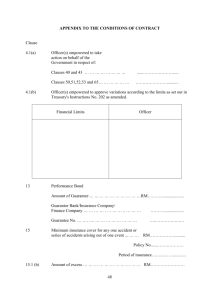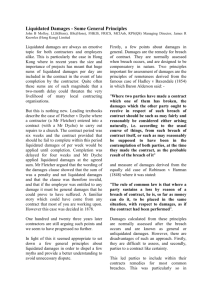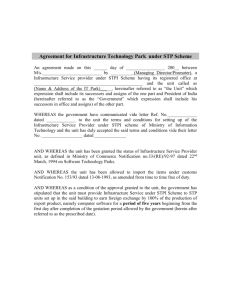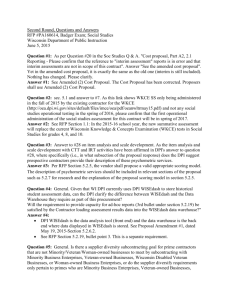OF DEBT OR LIQUIDATED DEMAND
advertisement
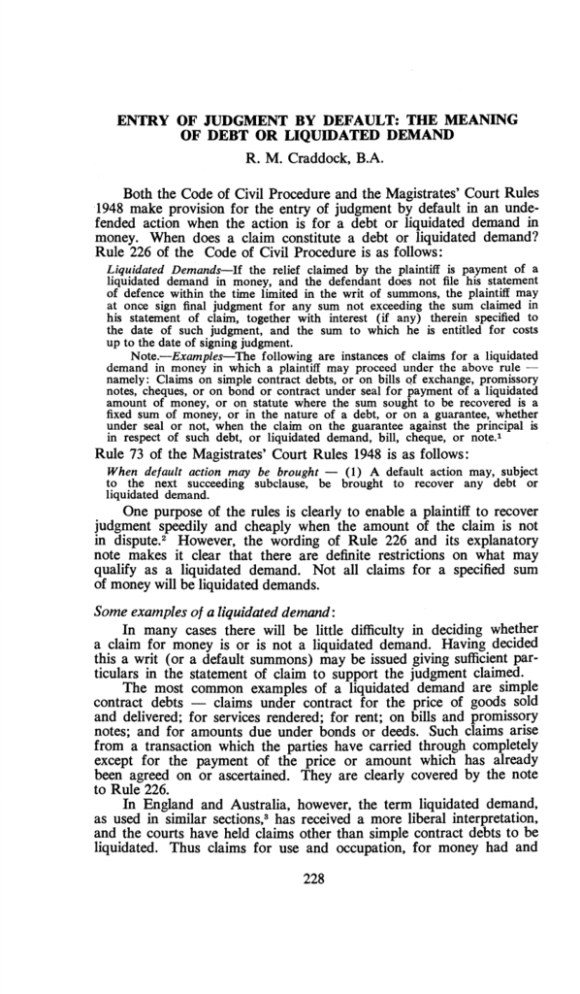
ENTRY OF JUDGMENT BY DEFAULT: THE MEANING OF DEBT OR LIQUIDATED DEMAND R. M. Craddock, B.A. Both the Code of Civil Procedure and the Magistrates' Court Rules 1948 make provision for the entry of judgment by default in an undefended action when the action is for a debt or liquidated demand in money. When does a claim constitute a debt or liquidated demand? Rule 226 of the Code of Civil Procedure is as follows: Liquidated Demands-If the relief claimed by the plaintiff is payment of a liquidated demand in money, and the defendant does not file hls statement of defence within the time limited in the writ of summons, the plaint3 may at once sign final judgment for any sum not exceeding the sum claimed in his statement of claim, together with interest (if any) therein specified to the date of such judgment, and the sum to which he is entitled for costs up to the date of signing judgment. Note.-Examples-The following are instances of claims for a liquidated demand in money in which a plaintiff may proceed under the above rule namely: Claims on simple contract debts, or on bills of exchange, promissory notes, cheques, or on bond or contract under seal for payment of a liquidated amount of money, or on statute where the sum sought to be recovered is a fixed sum of money, or in the nature of a debt, or on a guarantee, whether under seal or not, when the claim on the guarantee against the principal is in respect of such debt, or liquidated demand, bill, cheque, or note.1 Rule 73 of the Magistrates' Court Rules 1948 is as follows: When default action may be brought - (1) A default action may, subject to the next succeeding subclause, be brought to recover any debt or liquidated demand. One purpose of the rules is clearly to enable a plaintiff to recover judgment speedily and cheaply when the amount of the claim is not ~ the wording of Rule 226 and its explanatory in d i s p ~ t e . However, note makes it clear that there are definite restrictions on what may qualify as a liquidated demand. Not all claims for a specified sum of money will be liquidated demands. Some examples of a liquidated demand: In many cases there will be little difficulty in deciding whether a claim for money is or is not a liquidated demand. Having decided this a writ (or a default summons) may be issued giving sufficient particulars in the statement of claim to support the judgment claimed. The most common examples of a liquidated demand are simple contract debts - claims under contract for the price of goods sold and delivered; for services rendered; for rent; on bills and promissqry notes; and for amounts due under bonds or deeds. Such claims arise from a transaction which the parties have carried through completely except for the payment of the price or amount which has already been agreed on or ascertained. They are clearly covered by the note to Rule 226. In England and Australia, however, the term liquidated demand, as used in similar section^,^ has received a more liberal interpretation, and the courts have held claims other than simple contract debts to be liquidated. Thus claims for use and occupation, for money had and received, for a quantum meruit, and, in certain cases, for damages for breach of contract have been regarded as liquidated demands. It is by no means clear that these are included within the meaning of Rule 226. Thus in Beech v. Potter4 an action for use and occupation was held to be a liquidated demand. Madden C.J. said at p.332: In the present case "use and occupation" is the form in which the plaintiff sues and that has always been an action which came within the category of debt. It is said that it ought not to have come within the category because this is an action for an unliquidated money demand - an indefinite sum. It is said that use and occupation is distinguished from rent - that it is a claim for a n amount representing the reasonable value of the use of the premises and is not specific. But the same criticism would apply to a case of goods sold and delivered, or work and labour done, or interest upon money, or money had and received, in many of which the amount has to be ascertained, because no specific amount has been agreed upon. All these are unquestionably actions of debt, or for a liquidated demand, notwithstanding the actual amount has not been determined beforehand, but has to be estimated on stated terms, if the plaintiff is right. On the other hand, a contrary view was expressed by the Supreme C.J. held that Court in New Zealand in Mitchell v. Diederich."tout a claim for use and occupation was an unliquidated demand and not included in Rule 226. In Horrigan v. McPlzerson~'BeckettJ. held that a claim for the return of a deposit of £50 paid under a contract induced by fraud and misrepresentation was a liquidated demand. . . . this is not an action for damages. It would be properly described . . . as a claim for £50. That is a liquidated demand, and is an action for money had and received, and would come within the words of sec.64. In G. L. Baker Ltd. v. Barclays Bank, Ltd.7 also, a claim for money "fraudulently converted" by the defendant was held to be a liquidated demand. Lord Evershed M.R. said at p.521: Counsel for the defendants argued that, as the writ had been indorsed, it was a claim founded on the tort of conversion; and that though, in the classic phrase, the plaintiffs might "god-like have waived the tort" and sued for money had and received, they did not do so; and consequently their proper relief was by way of damages. . . I have come to the conclusion that it would not be right to give to the phrase "liquidated demand" so narrow and technical a significance. If I look at the writ . . . it is plainly, according to the language and in its context, a claim to recover the sum of £10,648 exactly, that sum being, as the writ alleges, the plaintiff's money or property which had been fraudulently converted by the third defendants. In Lagos v. Grunwaldts a claim for a quantum meruit was held to be liquidated. The plaintiff, who had acted as the legal representative of the defendants during litigation in South America, sent in his bill of costs to their solicitors in England, and afterwards issued a specially indorsed writ against them, claiming £1469 for professional charges and disbursements. Farwell L.J. held (at p.48) that: It is a claim on contract for quantum meruit. In my opinion that is within the rule. I think the words "debt or liquidated demand" point to the old division of common law actions to be found in Bullen and Leake 2nd ed., p.28. . . And the learned authors go on to say, "there were also formerly in use counts known as quantum meruit and quantum valebat counts, which were adopted where there was no fixed price for work done or goods sold . . . These counts, however, have fallen into disuse, and have been suspended by the general indebitatus counts." In my opinion that is the true view; everything that could be sued for under these counts comes within the description of debt or liquidated demand.9 From the preceding examples it is clear that in England and Australia claims other than those suggested by the note to Rule 226 have been considered liquidated demands, and there are even suggestions that a claim for a stipulated or precise sum in damages might be included.1° Eflect of the note to Rule 226: Since 1966, it may no longer be relevant even to consider whether claims in damages may be liquidated demands, for in Paterson v. Wellington Free Kindergarten Association Inc.ll our Court of Appeal expressed the view that interpretation of the term "liquidated demand" is a question of practice, which should be determined primarily on the wording of our own rule. McCarthy J. in delivering the judgment of the court said at p.982: An illustrative note such as we have is not to be found attached to any of the related English orders. Our rule, obviously, must be read as a whole and the note given its full value as an aid to interpretation. One implication to be drawn from this passage is that the effect of the note is to restrict the meaning of the term liquidated demand to include only those claims of which examples are given, and that consequently the term may have a narrower meaning than has been given it in England and Australia. However, with respect, it is suggested that giving "full value to the note as an aid to interpretation" does not support such a conclusion. First, most examples given in the notes are of types of claim which have always been accepted in England as being liquidated demands. The only exception is that of a claim for money due under statute, and this is an addition to, rather than a qualification of the term. It is difficult to see, therefore, how the mere enumeration of classes or types of liquidated demand can qualify or limit the meaning of the phrase; though it may have operated as a limitation had the examples given been specific. Secondly the note purports only to give examples ("The following are instances of claims"). There is no clear indication that these in any way limit or attempt to define a liquidated demand. This might have been the result had the wording been: "A liquidated demand means (and includes) claims for. . ." However, in the absence of such wording it is submitted that the note does no more than give examples, thus permitting the inference that there may be others. Even if the correct view is that the note restricts the meaning of the term to only those claims of which examples are given, this may result in an interpretation no less liberal than has been given in England; for the phrase "or in the nature of a debt," which occurs about half way through the examples, is itself capable of a wide interpretation.12 The term "simple contract debt" has already been used in the note. Therefore the term "in the nature of a debt" must mean something more,13 and is probably wide enough to include claims for money had and received, or for a reasonable price for goods supplied or services rendered. If, as has been suggested, Rule 226 does not prescribe the limits of a liquidated demand, then our courts must still be concerned with the definition of the term as used by Rule 226, and in particular as used by Rule 73 of the Magistrates' Courts Rules 1948 which does not have such a note. Attempts at Definition : These have been numerous, especially in England, but none of them is completely satisfactory. One which has been referred to in many decisions is to be found in 8 Encyclopaedia of the Laws of England :l 4 In order to come within the definition "liquidated demand" a claim on a contract must (a) state the amount demanded, or must be so expressed that the ascertainment of the amount is a mere matter of calculation; and (b) must give sufficient particulars of the contract to disclose its nature. It is the nature of the contract on which the claim is based, as well as the fact that a specific sum is claimed, which brings the claim, or fails to bring it, within the definition. Other definitions, varying mainly in their emphasis, are to be found in (a) the note to R.S.C. 0 , 6 r.2(4) in the Supreme Court Practice 1967 Vol. 1 ; (b) Odgers Pleading and Practice 5th ed. 41; approved in Spain v. Union Steam Ship Co. o f New Zealand Ltd.;15 (c) Beech v. Potter16 approving Horrigan v. McPherson.17 Although none of these definitions is alone exhaustive, they all give as essential features of a liquidated demand (a) that the claim be in pursuance of a contract, and (b) that the amount claimed be ascertained or ascertainable by a mere process of calculation. A contrary view has been expressed by Barrowclough C.J. in Wing v. Leeder18 a decision which gave rise initially to considerable speculation and hasty directives to officers of the Magistrates' Court. In that case, a claim for damages in tort was held to be a liquidated demand, therefore within Rule 226. The Chief Justice said at p.32: It is obvious enough that most claims for damages in tort will be in the nature of unliquidated demands; but in my opinion there are some claims in tort which are clearly liquidated and within the scope of R.226. and at p.33 : Generally speaking a n amount is liquidated when it is made clear or plain or when it is settled and determined - usually by agreement or litigation . . . Thus if a plaintiff is injured as the result of a motor accident his c l a m for general damages is clearly not a liquidated demand; but if he claims only a week's loss of wages and the expenses of medical and hospital attention those claims are quite clearly liquidated demands. Generally speaking, all claims special damages would appear to be liquidated demands in money; . . . The Court of Appeal in Paterson's case did not mention the decision, although naturally enough it was cited to the Chief Justice by counsel in the hearing at first instance. Barrowclough C.J. was of the opinion that his earlier decision was authority for the proposition that where the quantum of a claim was settled and not in dispute, then the claim would be a liquidated demand.lg It is respectfully submitted that the judgment in Wing v. Leeder discloses some confusion about the nature of a liquidated demand, and in particular about the nature of special damages. First, a claim for a reasonable price of goods sold or work done may be a liquidated demand even though the quantum of the claim is open to dispute. Thus the test is not whether the amount has been "settled by agreement or litigation", but whether it is ascertained or able to be ascertained according to some predetermined scale or rules impliedly adopted when the contract was entered into. Secondly, it has never been suggested in any earlier decision in the Commonwealth that damages in tort are capable of being liquidated, let alone capable of being recovered under Rule 226. Indeed tortious liability has been defined in the following terms: Tortious liability arises from the breach of a duty primarily fixed by the law; this duty is towards persons generally and its breach is redressible by an action for unliquidated damages.20 The action for unliquidated damages is one fairly sure test of tortious liability and it has some show of express judicial approval.21 In considering that special damages in tort might be liquidated demands, the Chief Justice appears to have confused the distinction between "special" damages and "liquidated" damages. The essence of special damage is that it represents "such a loss as the law will not presume to be the consequence of the defendant's act. . . It must therefore be always explicitly claimed on the pleading, as otherwise the defendant would have no notice that such sum of damage would be claimed from him at the Special damages are still damages at large and are therefore unliquidated unless there has been some agreement as to the amount, reached before the cause of action arose. In the words of Lord Dunedin in Dunlop Pneumatic Tyre Co. v. New Garage and Motor Co. Ltd.,23 'Yhe essence of liquidated damages is a genuine covenanted pre-estimate of damage." It is thus clear why liquidated damages can arise only in contract, and never in tort. One practical conclusion to be drawn is that a default summons should not be issued in the Magistrate's Court to recover for property damage resulting from a motor accident. A repair account is not always the proper measure of the plaintiff's loss; it is evidence only of an assessment of damage and must still be proved: Donald Church Ltd. v. Stringer;24 Methven v. T ~ i t .As ~ ~has already been indicated, damages in contract may be liquidated. Thus, where a sum of money is stipulated as being payable by way of damages in the event of a breach of contract, and that sum represents a genuine pre-estimate of the damage which would probably have arisen from such breach, it is treated as "liquidated damages" and would therefore become, for the purpose of Rule 226, a liquidated demand.26 Conclusion : Although no satisfactory analytical definition of the phrase has been advanced, the courts in England and Australia have recognised that "debt or liquidated demand" has a history of judicial interpretation, and that its scope is clearly limited. Perhaps the most scholarly, and certainly the most thorough study is to be found in the judgment of Sholl J. in Alexander v. Ajax Insurance Co. Ltd.27 After examining some of the definitions which have been referred to above,28Sholl J. cited the First Report of the Common Law Commissioners, 1851 in which the term was first used. From this he concluded that, .. . the best statement which can be attempted of the meaning of the expression "debt or liquidated demand (in money)", as used in 1851, is that it covered any claim :(a) for which the action of debt would lie (b) for which an indebitatus (or "common") count would lie - including those cases formerly covered by the quantum meruit or quantum valebat counts, notwithstanding that the only agreement implied between the parties in such cases was for payment at a "reasonable rate". (c) for which covenant, or special assumpsit, would lie, provided that the claim was for a specific amount, not involving in the calculation thereof elements the selection whereof was dependent on the opinion of a jury. In my opinion . . . that is still the meaning of the relevant expressions which have been carried down since that date into what are now Orders 111, XIS, XIV, XXVII.29 This does not provide a simple formula by which any particular claim may be tested, but it at least furnishes a complete description of the claims covered, which, in any particular case, can be tested by reference to past authority. 1 The note which follows the actual rule is part of the rule itself, and not an editorial gloss: Paterson v. Wellington Free Kindergarten Association Inc. [I9661 N.Z.L.R.975, 981 per McCarthy J. The word "Examples" does not appear in the Second Schedule to the Judicature Act 1908. It appears m its present position for the first time in the 9th edition of Sim's Pracfice and Procedure (1955), and in earlier editions, appears only as a marg~nal note. 2 Wing v. Leeder [1961] N.Z.L.R.30, 33 per Barrowclough C.J. 3 Neither the equivalent English or Australian provisions have a note such as forms part of Rule 226. See page 230 infra. 4 (1904) 29 V.L.R.830. 5 (191 1) 30 N.Z.L.R.480, 481. 6 (1903) 29 V.L.R.139, 142. 7 119561 3 All E.R.519. 8 [I9101 1 K.B.41. See also Spain v. The Union Steam Ship Company o f New Zealand Ltd. (1923) 32 C.L.R.138, where a claim for reasonable expenses was held to be a liquidated demand; and Runnacles v. Mesquita (1876) 1 Q.B.D.416. 9 Farwell L.J. does not make it clear whether he meant that only those claims that could have been sued for under those counts come within the meaning of debt or liquidated demand, or whether he was allowing that there may be other instances of liquidated demands. 10 Dunlop Pneumatic Tyre Co. Ltd. v. New Garage and Motor Co. Ltd. [I9151 A.C.79, 86; Alexander v. Ajax lnsrcrance Co. Ltd. [I9561 V.L.R.436, 442. 11 [I9661 N.Z.L.R.975. 12 The phrase "or in the nature of a debt" is not part of the preceding clause referring to a claim for a fixed sum of money recoverable under statute; it is clearly a further instance of "claims for a liquidated demand in money." 13 See The Supreme Court Practice (1967) Vol. 1, 0.6 r.2(4) : "a liquidated demand is in the nature of a debt." 14 2nd ed. (1908) 338. 15 (1923) 32 C.L.R.138, 142. 16 (1904) 29 V.L.R.830, 832 per Madden C.J. 17 supra note 6. 18 [I9611 N.Z.L.R.30. 19 [I9661 N.Z.L.R.468, 472. 20 Winfield on Tort, 7th ed. (1965), 5. 21 Hulton v. Hulton [I9171 1 K.B.813, 820, 822-823, 824. 22 Bullen & Leake's Precedent of Pleadings, 11th ed., 38. 23 [I9151 A.C.79, 86. (H.L.). 24 (1950) 7 M.C.D.130. 25 (1965) 11 M.C.D.423. 26 Dunlop Pneumatic Tyre Co. Ltd. v. New Garage & Motor Co. Ltd. supra: Clydebank Engineering & Shipbuilding Co. Ltd. v. Don Jose Ramos [I9051 A.C.6; and an unreported case decided by Pollock B. in 1889, cited in the notes to O.XISI r.3 at p.154 of the Annual Practice (1952). 27 [I9561 V.L.R.436, 445. 28 supra p.231. 29 This is wider than the proposition expressed by Farewell L.J. in Lagos v. Grunwaldt (supra p.229) which would not cover a claim for liquidated damages fixed by a contract. See note 26 supra.

